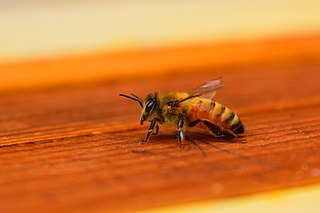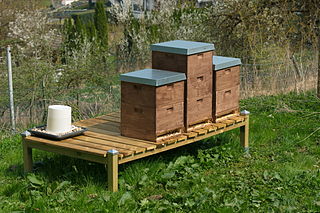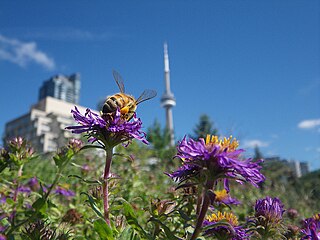Related Research Articles

Honey is a sweet and viscous substance made by several bees, the best-known of which are honey bees. Honey is made and stored to nourish bee colonies. Bees produce honey by gathering and then refining the sugary secretions of plants or the secretions of other insects, like the honeydew of aphids. This refinement takes place both within individual bees, through regurgitation and enzymatic activity, as well as during storage in the hive, through water evaporation that concentrates the honey's sugars until it is thick and viscous.

A honey bee is a eusocial flying insect within the genus Apis of the bee clade, all native to mainland Afro-Eurasia. After bees spread naturally throughout Africa and Eurasia, humans became responsible for the current cosmopolitan distribution of honey bees, introducing multiple subspecies into South America, North America, and Australia.

A beehive is an enclosed structure in which some honey bee species of the subgenus Apis live and raise their young. Though the word beehive is commonly used to describe the nest of any bee colony, scientific and professional literature distinguishes nest from hive. Nest is used to discuss colonies that house themselves in natural or artificial cavities or are hanging and exposed. Hive is used to describe an artificial/man-made structure to house a honey bee nest. Several species of Apis live in colonies, but for honey production the western honey bee and the eastern honey bee are the main species kept in hives.

Beekeeping is the maintenance of bee colonies, commonly in man-made beehives. Honey bees in the genus Apis are the most-commonly-kept species but other honey-producing bees such as Melipona stingless bees are also kept. Beekeepers keep bees to collect honey and other products of the hive: beeswax, propolis, bee pollen, and royal jelly. Pollination of crops, raising queens, and production of package bees for sale are other sources of beekeeping income. Bee hives are kept in an apiary or "bee yard".

Pollination management is the horticultural practices that accomplish or enhance pollination of a crop, to improve yield or quality, by understanding of the particular crop's pollination needs, and by knowledgeable management of pollenizers, pollinators, and pollination conditions.
An apiary is a location where beehives of honey bees are kept. Apiaries come in many sizes and can be rural or urban depending on the honey production operation. Furthermore, an apiary may refer to a hobbyist's hives or those used for commercial or educational usage. It can also be a wall-less, roofed structure, similar to a gazebo which houses hives, or an enclosed structure with an opening that directs the flight path of the bees.

In modern American beekeeping, a Langstroth hive is any vertically modular beehive that has the key features of vertically hung frames, a bottom board with entrance for the bees, boxes containing frames for brood and honey and an inner cover and top cap to provide weather protection. In a Langstroth hive, the bees build honeycomb into frames, which can be moved with ease. The frames are designed to prevent bees from attaching honeycombs where they would either connect adjacent frames, or connect frames to the walls of the hive. The movable frames allow the beekeeper to manage the bees in a way which was formerly impossible.

A honey extractor is a mechanical device used in the extraction of honey from honeycombs. A honey extractor extracts the honey from the honey comb without destroying the comb. Extractors work by centrifugal force. A drum or container holds a frame basket which spins, flinging the honey out. With this method the wax comb stays intact within the frame and can be reused by the bees.
Liwonde National Park, also known as Liwonde Wildlife Reserve, is a national park in southern Malawi, near the Mozambique border. The park was established in 1973, and has been managed by the nonprofit conservation organization African Parks since August 2015. African Parks built an electric fence around the perimeter of the park to help mitigate human-wildlife conflict. In early 2018, the adjacent Mangochi Forest Reserve was also brought under African Parks' management, almost doubling the size of the protected area.

The Cape honey bee or Cape bee is a southern South African subspecies of the western honey bee. They play a major role in South African agriculture and the economy of the Western Cape by pollinating crops and producing honey in the Western Cape region of South Africa. The species is endemic to the Western Cape region of South Africa on the coastal side of the Cape Fold mountain range.
Iain Douglas-Hamilton, D.Phil., CBE, is an authority on elephant behaviour and conservation. He attended Gordonstoun School, and later Oxford University where he earned a degree in Zoology and a D.Phil studying the Ecology and Behaviour of the African Elephant. His work in the 1960s paved the way for much of today’s understanding of elephants and current conservation practices. During the 1970s, he investigated the status of elephants throughout Africa and was the first to alert the world to the ivory poaching crisis. He chronicled the diminution of Africa’s elephant population by half between 1979 and 1989 and was instrumental in bringing about the world ivory trade ban. In 1993, Douglas-Hamilton founded Save the Elephants (STE) a charity dedicated specifically to elephants. Since that time, Save the Elephants has conducted research on elephant across Africa and has increased public awareness of the many dangers that threaten elephants and the habitats in which they live. Fundamental to his work at STE, Douglas-Hamilton pioneered GPS tracking of elephants in Africa, which has become a standard and widely emulated survey technique; it also guides the deployment of rangers to protect vulnerable and key elephant populations. Douglas-Hamilton and his wife, Oria, have co-authored two award-winning books, Among the Elephants (1975) and Battle for the Elephants (1992), and have made several television films. Dr. Iain Douglas-Hamilton was awarded the 2010 Indianapolis Prize, one of the world's leading awards for animal conservation. In 2013 The Elephant Crisis Fund was established to confront the threat to elephants by supporting the most urgent, important and catalytic projects across the crisis to stop the killing, stop the trafficking and end the demand for ivory. In October 2014 he was presented with the George B Rabb Conservation Medal by the Chicago Zoological Society (CZS) for his authoritative work to benefit African elephants. In 2015 he was awarded the Commander of the British Empire and was presented the Lifetime Achievement Award by San Diego Zoological Society with most recently being awarded the Tanzanian Wildlife Research Institute’s (TAWIRI) Tanzania Wildlife Research Award for his lifelong devotion to elephants. Currently he is focused on winning hearts and minds to help reduce the demand for ivory, and focus on understanding elephant’s reasons for movements, and their deep history in time.

Human–wildlife conflict (HWC) refers to the negative interactions between human and wild animals, with undesirable consequences both for people and their resources, on the one hand, and wildlife and their habitats on the other. HWC, caused by competition for natural resources between human and wildlife, influences human food security and the well-being of both humans and animals. In many regions, the number of these conflicts has increased in recent decades as a result of human population growth and the transformation of land use.

Colony collapse disorder (CCD) is an abnormal phenomenon that occurs when the majority of worker bees in a honey bee colony disappear, leaving behind a queen, plenty of food, and a few nurse bees to care for the remaining immature bees. While such disappearances have occurred sporadically throughout the history of apiculture, and have been known by various names, the syndrome was renamed colony collapse disorder in early 2007 in conjunction with a drastic rise in reports of disappearances of western honey bee colonies in North America. Beekeepers in most European countries had observed a similar phenomenon since 1998, especially in Southern and Western Europe; the Northern Ireland Assembly received reports of a decline greater than 50%. The phenomenon became more global when it affected some Asian and African countries as well.

Save the Elephants (STE) is a UK registered charity based in Kenya founded in September 1993 by Iain Douglas-Hamilton. Save the Elephants works to sustain elephant populations and preserve the habitats in which elephants are found, while at the same time fostering a heightened appreciation and visibility for elephants and their often fragile existence. The organization uses a four pillar approach to fulfill its mission statement, combining habitat protection, research, grass roots organization and involvement, and through disseminating information through television, films, publications and new media sources.

Urban beekeeping is the practice of keeping bee colonies (hives) in towns and cities. It is also referred to as hobby beekeeping or backyard beekeeping. Bees from city apiaries are said to be "healthier and more productive than their country cousins". As pollinators, bees also provide environmental and economic benefits to cities.
A beehive fence is a fence which is built to deter elephants based on their natural fear of bees.
Honey bee starvation is a problem for bees and beekeepers. Starvation may be caused by unfavorable weather, disease, long distance transportation or depleting food reserve. Over-harvesting of honey is the foremost cause for scarcity as bees are not left with enough of a honey store, though weather, disease, and disturbance can also cause problems. Backyard beekeepers face more colony losses in the winter than in the summer, but for commercial beekeepers there is not much variation in loss by season. Starvation may be avoided by effective monitoring of hives and disease prevention measures. Starvation can amplify the toxic effect of pesticides bees are exposed to.

Mavis Nduchwa, also known as Rewana Nduchwa, was the founder and CEO of the agribusiness Chabana farms, which also trades as Kalahari Honey. She is a motswana entrepreneur, who is one of the 2020 Jack Ma foundation top 50 Africa Business Heroes finalist.
Sathanur is a village in Ramanagara district of Karnataka, India. It is located around 70 km from the city of Bengaluru. The Bengaluru - Coimbatore National Highway 948 passes via this town.

Honeybee Heroes in a honeybee sanctuary and beekeeper education non-profit organisation founded in 2020 by Chris Oosthuizen in the Overberg region of South Africa.
References
- ↑ SAVE THE ELEPHANTS (14 November 2015). "African honey bees change lives and save elephants". YouTube . Retrieved 16 August 2018.
- ↑ "Into The Unknown With Josh Bernstein from Lucy King on Vimeo". Player.vimeo.com. Retrieved 16 August 2018.
- ↑ "ELEPHANT-FRIENDLY HONEY". Elephantsandbees.com. 19 May 2015. Retrieved 16 August 2018.
- ↑ "About Us". Elephantsandbees.com. 11 August 2013. Retrieved 16 August 2018.
- ↑ "Elephants & Bees Media Library". Elephantsandbees.com. 15 August 2013. Retrieved 16 August 2018.